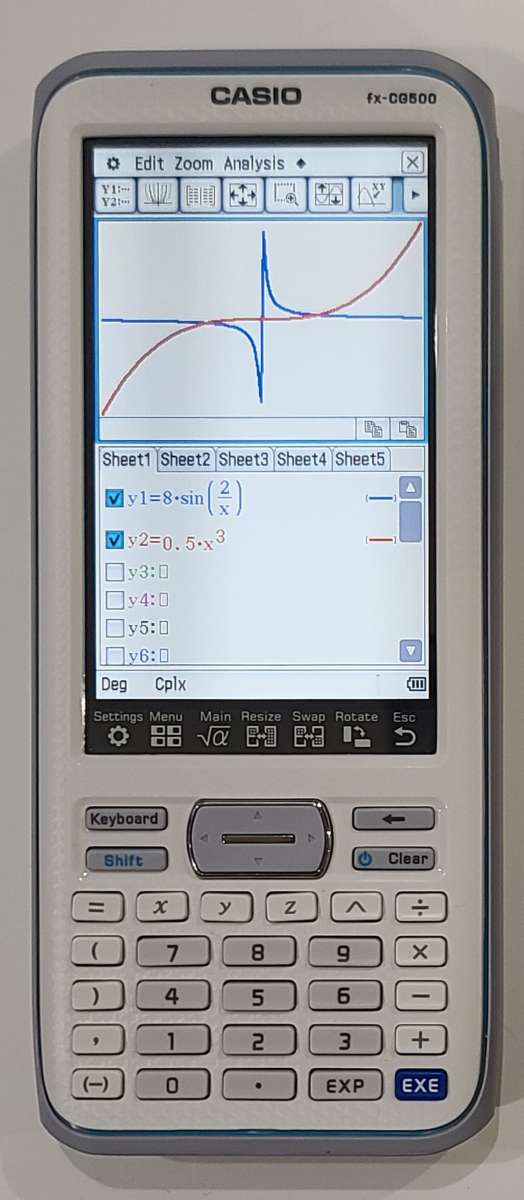
REVIEW – While smartphones and tablets have many calculator app options, they cannot be used on exams administered by the College Board. The Casio fx-CG500 is the preeminent graphing calculator made by Casio that is College Board approved (without using the stylus). I have one to review; read on to see what I think!
What is it?
The Casio fx-CG500 is a full-color large-screen graphing calculator. The screen is resistive touch capable and back-lit. The items on the screen may be selected and manipulated by drag and drop and the screen can be used as a soft keyboard. The fx-CG500 has a computer algebra system installed, meaning that it has software that can manipulate mathematical expressions and other mathematical objects symbolically. The calculator also can load and save modules for use in the classroom or in independent study. The calculator can communicate with a computer to save and load programs and calculation results, another calculator, a projector, and specialized data loggers.
What’s included?
- Casio fx-CG500 calculator
- stylus
- slide-on protective hard cover
- mini USB to USB A cable
- 4 AAA Batteries
- Quick Start guides in English, Spanish, and French
Tech specs
Click to expand
- Product Features:
- Programmable,
- Financial,
- Graphing
- Computer Algebra System (CAS)
- Display digits: 10 + 3
- Display:
- Natural textbook display
- Icon menu
- Color display
- Backlight
- Dot matrix display
- High Resolution
- Touch Panel
- Power: 4 x AAA batteries provide about 100 hours of use
- Memory: 28 variable memory
- Basic Calculations:
- Basic operations
- Bracket Calculation
- Fraction Calculation
- Degree, Minute, Secound (Sexagesimal) Calculations
- Reciprocal Calculation
- Percent Calculation (scientific calculator function)
- Factorial Function
- Pi
- Irrational number calculation
- Rounding Function
- Advanced Calculations
- Transcendental number: e
- Base-n calculation
- Logical Operators
- Complex number calculation
- Matrix calculations
- Vector calculations
- Differential calculation
- Integration calculation
- Financial Calculations
- Simple Interest Mode
- Compound Interest Mode (Calculation)
- Cash Flow Mode (Calculation)
- Amortization Mode (Calculation)
- Conversion Mode (Calculation)
- Cost/Sell/Margin Mode (Calculation)
- Day Calculation Mode (Calculation)
- Depreciation Mode (Calculation)
- Bond Mode (Calculation)
- Break-Even Mode (Calculation)
- Function Features
- Basic Mathematical Functions
- Computer Algebra System (CAS)
- Absolute Value Calculation
- Power Function (Square)
- Power Function
- Power Function (Square Root)
- Trigonometric Function
- Inverse Trigonometric Function
- Hyperbolic / Inverse Hyperbolic Function
- Exponential Calculation
- Logarithmic Calculation
- Log not base 10
- Coordinate Conversion
- Combination / Permutation
- GCD / LCM
- Determine the Integer Part
- Prime Factorization
- Random Number Generation
- Random Integer Generation
- Summation
- Catalog Function
- Other Functions
- Spreadsheet
- Equation
- Inequality Calculations
- Recursion
- Geometry Application
- Periodic Table
- List Based STAT-Data editor
- Statistical Graphs
- Statistics Functions
- Distribution Calculations
- Graph Functions
- Rectangular coordinate graphing
- Polar coordinate graphing
- Parametric function graphing
- Inequality graphing
- Domain graph/ Range graph
- Integration graph
- Conic section graph
- Trace, Zoom (box zoom, zoom in, zoom out, auto zoom)
- Solve (root, minimum, maximum, intersection, integration)
- Sketch (tangent line, normal line, inverse function)
- Recursion graph
- 3D Graph
- Table and Graph
- Dual graph (table and graph, graph and graph)
- Dynamic graph
- Picture Plot (pre-installed software)
- File operations for Geometry
- Drawing and editing objects for Geometry
- Construct objects for Geometry
- Measurements of an object
- Animation
- BASIC like programming
- BASIC memory: 500 kB
- Examination Mode
Design and features
Unboxing
The Casio fx-CG500 graphing calculator comes in a full-color retail box. The front shows a picture of the calculator, and the back shows screenshots of the features and possible calculations.
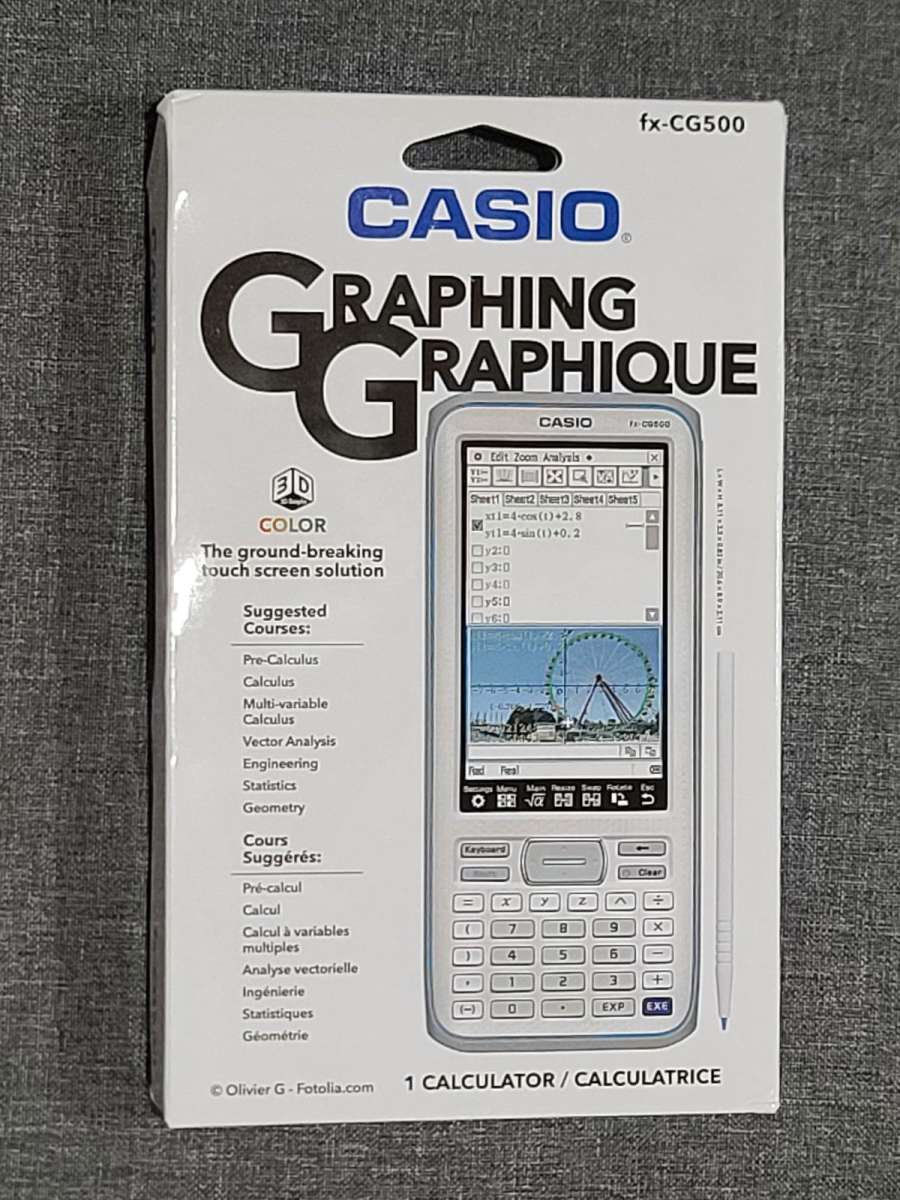
Inside a cardboard insert keeps the calculator protected. The calculator comes with the slide on protective hard cover taped in place.
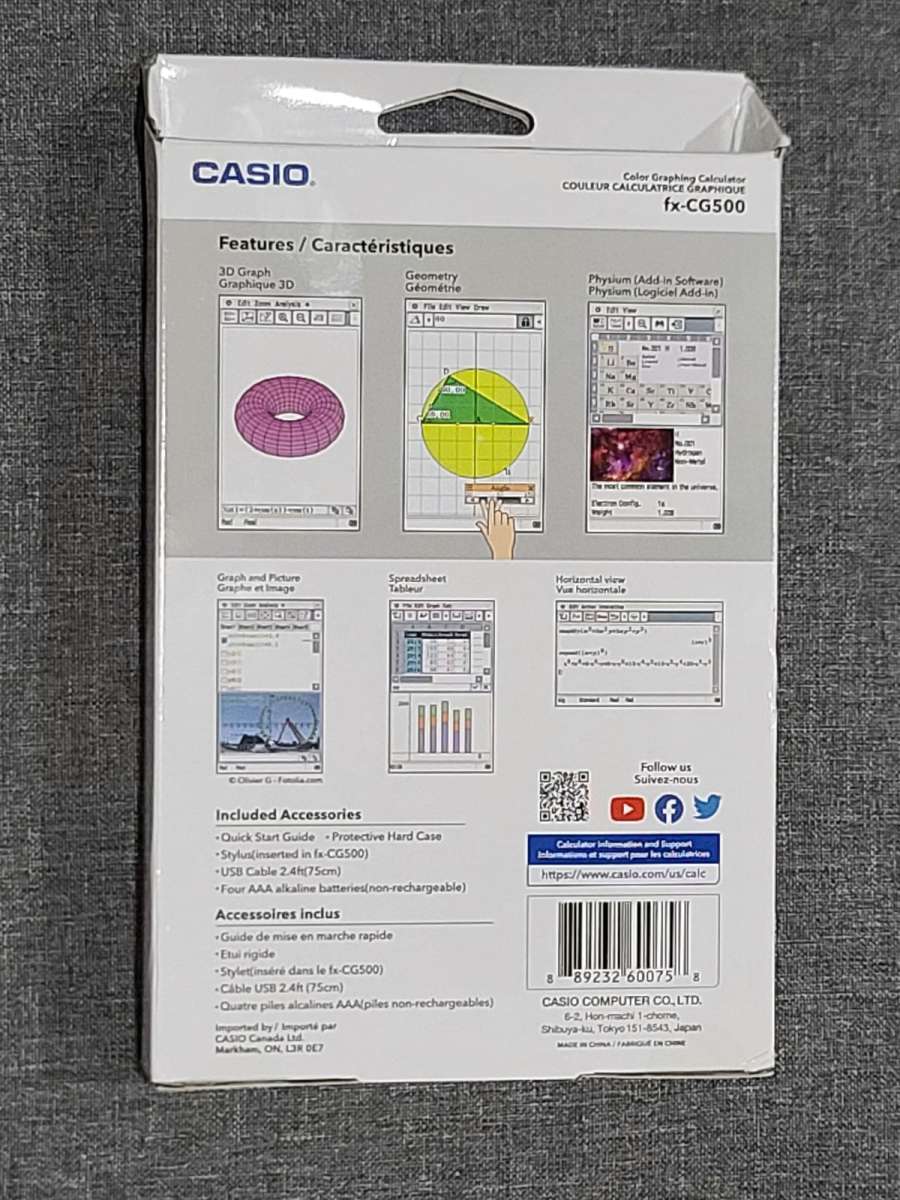
Assembly, Installation, Setup
The batteries need to be installed for the calculator to work. The calculator takes four AAA batteries which will provide about 100 hours of operation. The system can adjust the indication of remaining battery power to Alkaline or Ni-MH batteries accordingly. Apparently, the memory and functions of the calculator are stored in non-volatile memory so removing the batteries will not erase the calculator.
There is a place to enter the username on the about screen but this value can be edited anytime.
Design
The Casio fx-CG500 calculatorwas first sold in 2017 and the calculator sold today may not be markedly different. The longevity of the device is a testament to its design and utility.
It will not only help you in math, engineering and statistics, but may also make you stronger. The calculator weighs 11.0 ounces (without guard or stylus but with batteries) and measures 8.125 x 3.5 x 0.75 inches. You can see how much bigger it is than a TI-30XIIS and a modern TI-84.
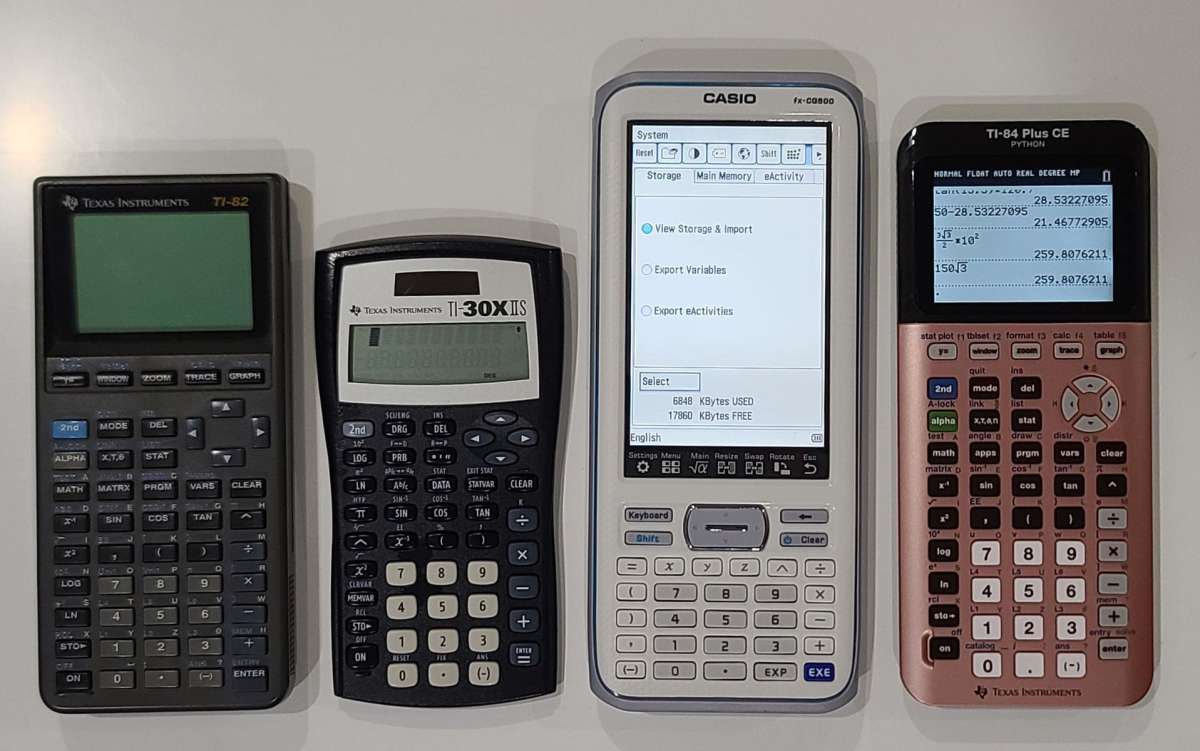

The back has a spring-loaded pocket to store the stylus. However, if the stylus is lost, I do not see an exact replacement online. (Any resistive stylus should do the trick, but it may not fit in the storage slot correctly.)
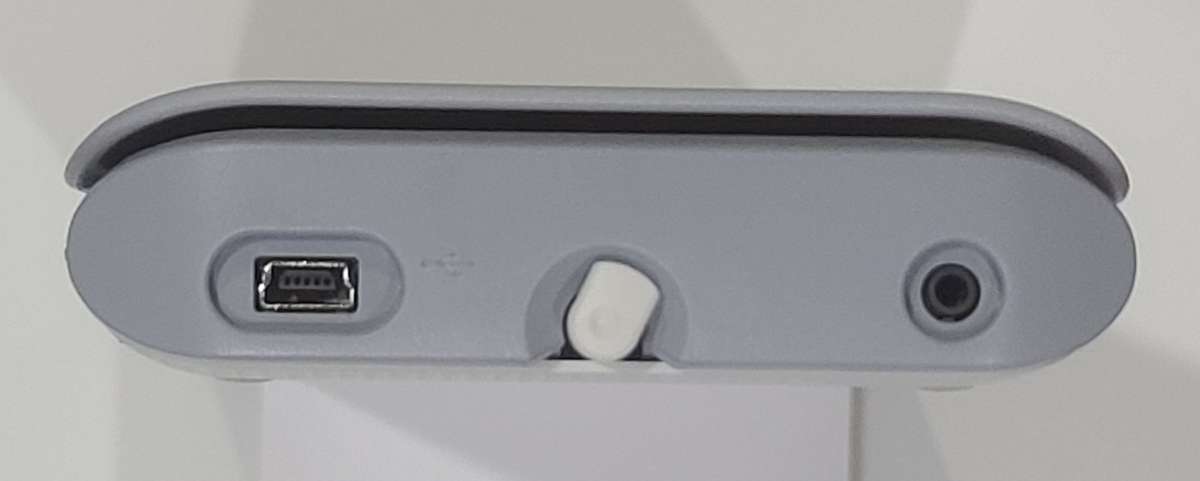
The construction is entirely out of plastic.
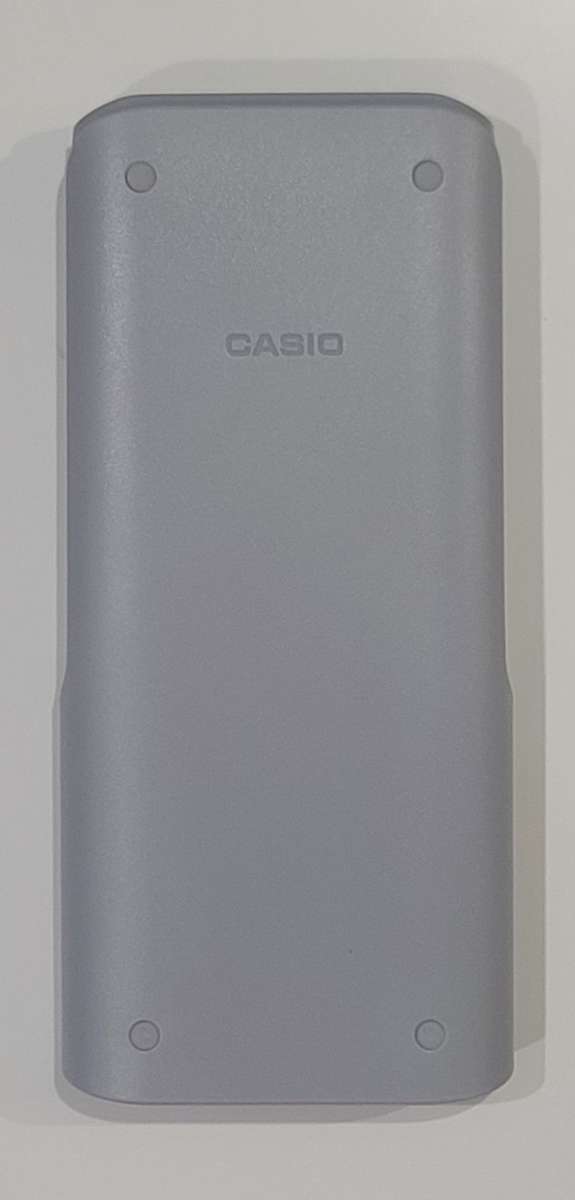
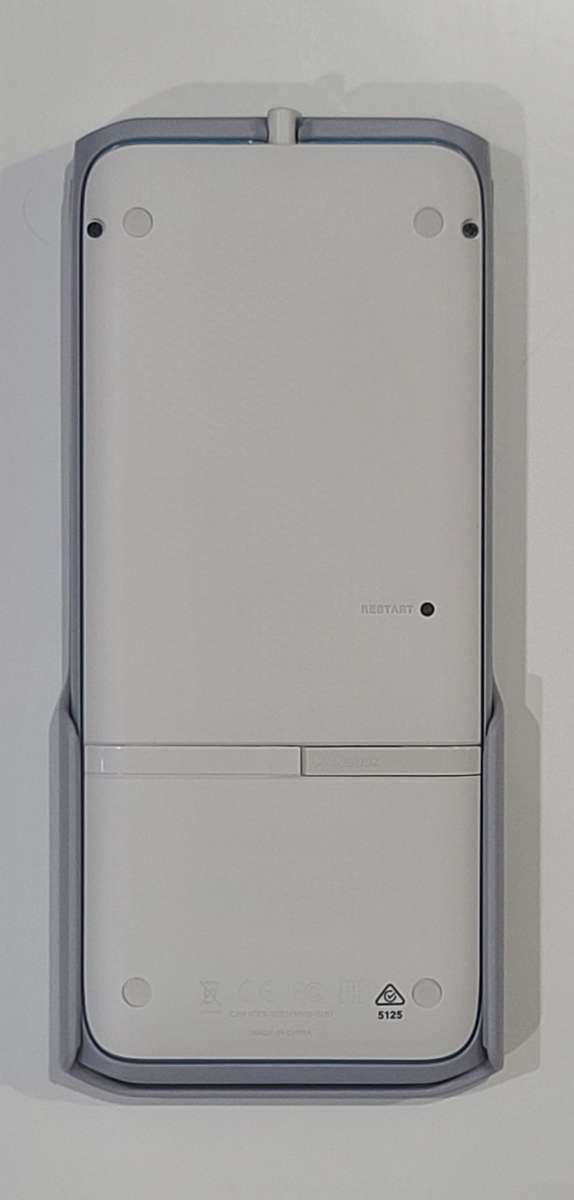
The design of the calculator looks very similar to a Sony Ericsson candy bar phone from 2009. There is a large display atop a matrix of tiny numeric buttons. The front panel has a texture that looks like it is 3D printed.
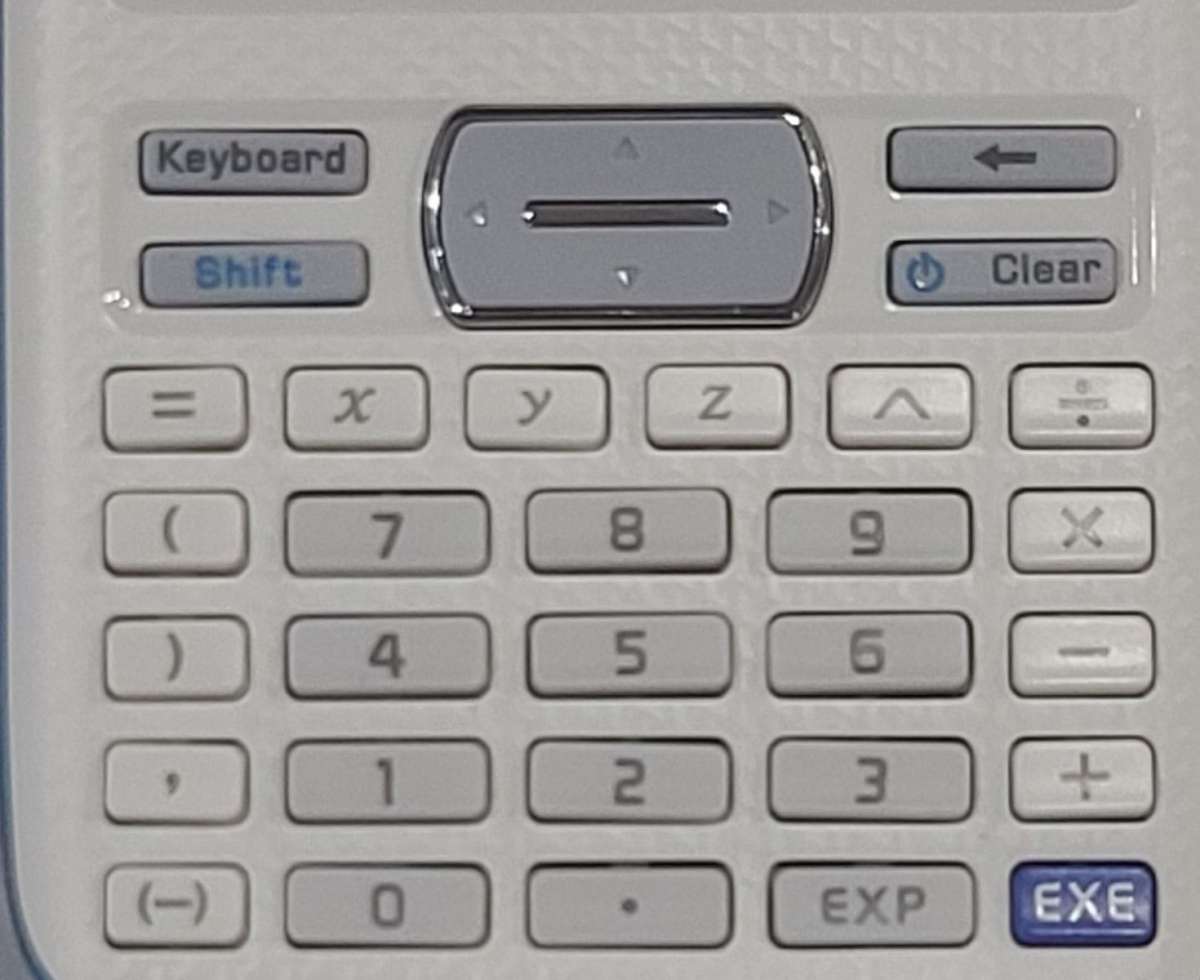
The calculator includes 34 actual physical buttons and 7 soft buttons on the lower half of the screen. There is a shift button that can call up shortcuts to other functions by pressing the corresponding key but there isn’t any indication as to what function is assigned. It would be great if there were a window that popped up with the assignments when this key is pressed. The soft keyboard on the screen is divided into nine tabbed menus. The Catalog menu lists every function available. I find that the soft keyboard may take longer to actually input the required expression, but it is easier to find what variables and symbols to use. The list of variables and alphabet are in alphabetical order because there is a prohibition of using QWERTY layout on calculators used in the College Board exams. Initially, the calculator will be easier to use than one like the TI-82,83,84 that has assigned hard buttons. Eventually, the user of the TI-84 may be faster than the Casio fx-CG500 user but maybe only marginally so.
The screen reminds me of the Palm Pilot in so many ways. From the resistive touch sensitivity to the 7 hard icons along the bottom to the soft plastic exterior, there are so many similarities it begs the question, “are these hardware technologies still cost-effective in 2017?” Just like the Palm Pilots of yore, the screen on this is a fingerprint magnet.
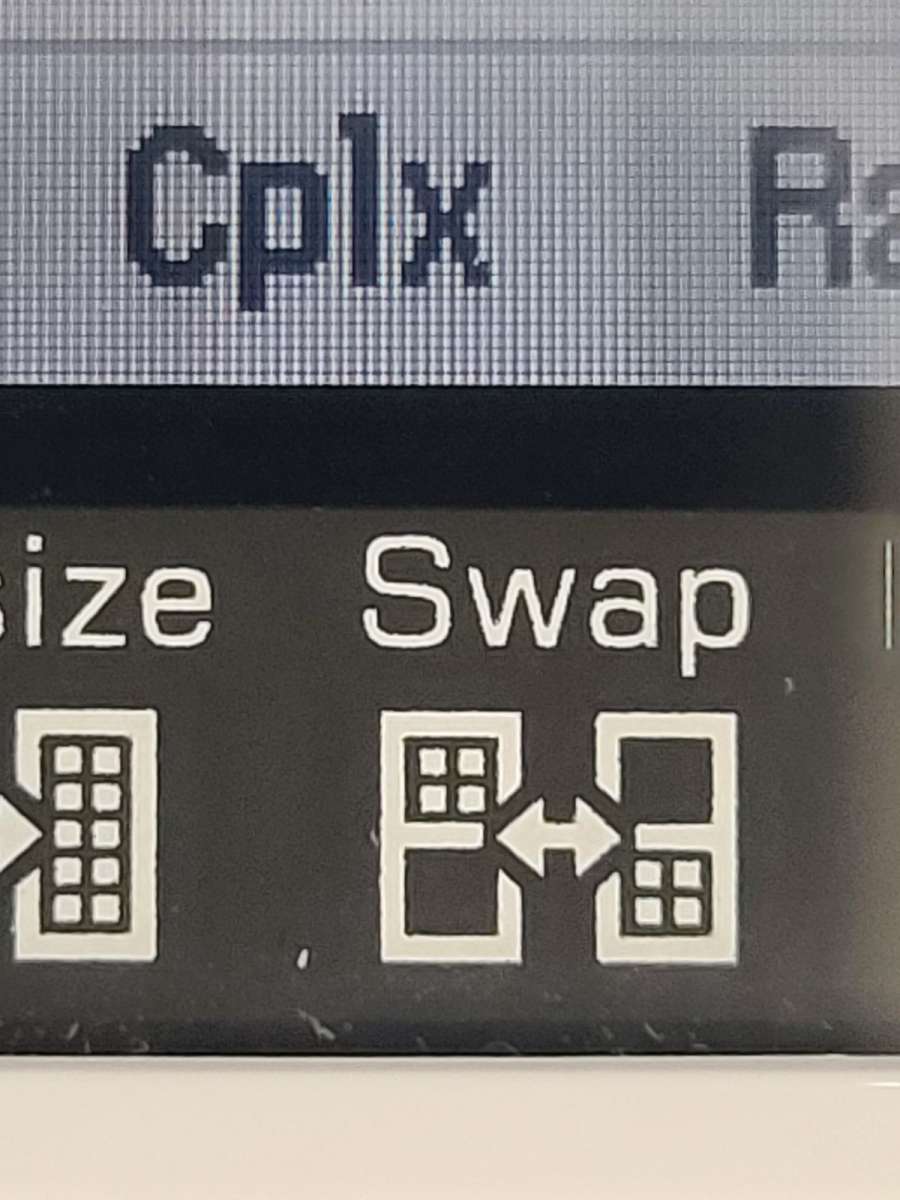
The screen looks to be a 320 x 530 resolution and 4.8″ diagonal. It has a narrow viewing angle (probably an anti-cheating feature) and has a glass substrate with a plastic resistive coating. Dropping this heavy calculator is probably going to break it. But criticisms and comparisons to phones aside, this is probably the best-looking screen on a calculator available. It’s obvious on the comparison shots of the fx-CG500 and the TI-84 Plus CE that the fonts look much more well defined, and the natural textbook display makes equations easier to read and less likely to include errors from nested parenthesis. Note that the Casio can fit twice as much info on the screen as the HP.
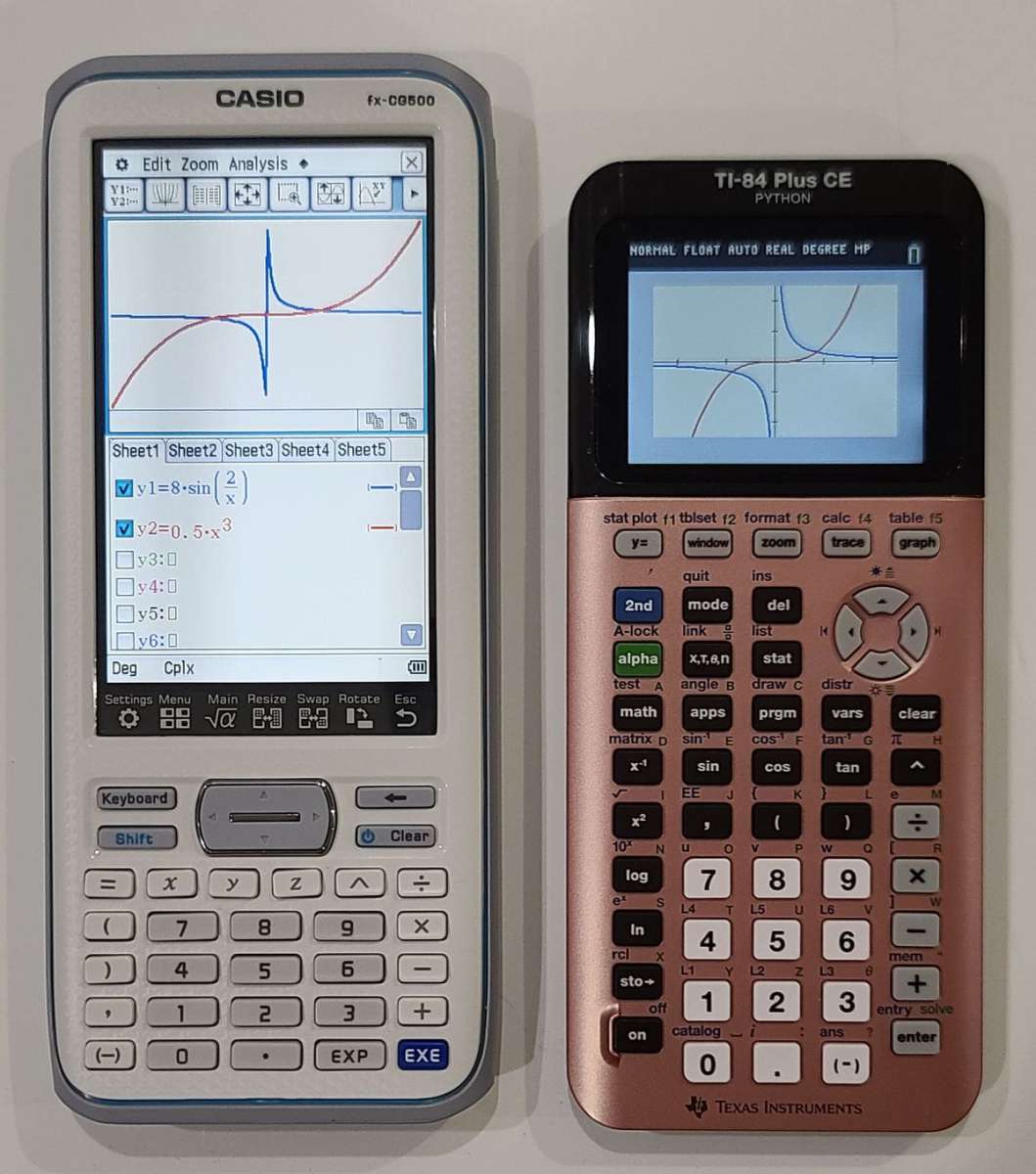
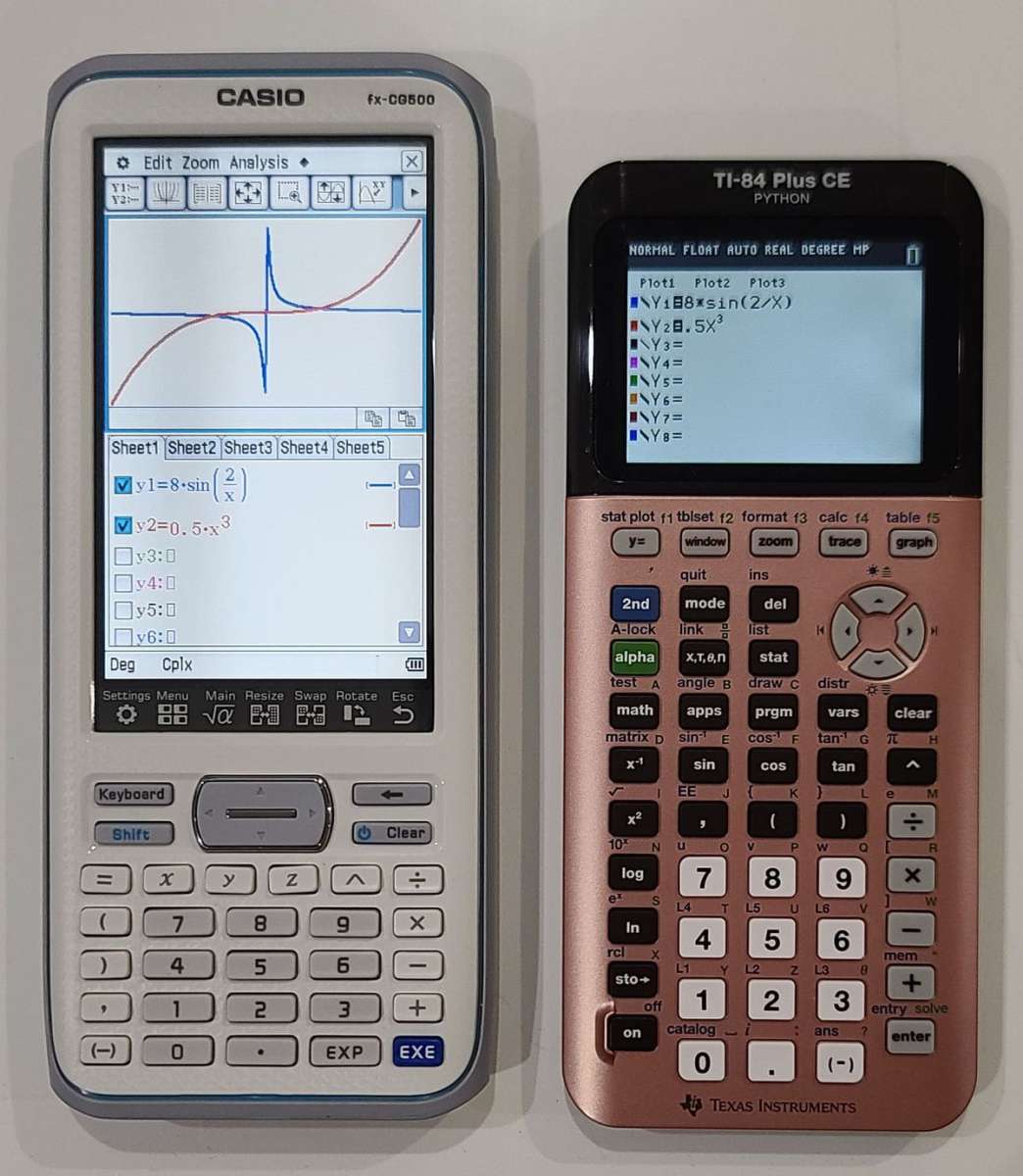
The comparison shots also show that the buttons are a bit smaller on this model than on the TI brands.
Performance
The Casio fx-CG500 can do so many things that it would take a book to really demonstrate the performance of the calculator. In fact, the manuals for the calculator are here and reviewing them gives a good impression of the full capabilities of the fx-CG500.
The screen resolution and clarity have to be reiterated. The display of the differential equation vector field and solutions are crisp and clear. I appreciate that Casio makes the italic and Roman fonts distinct. The Casio also has a Greek and Cyrillic alphabet and a full set of Spanish, French, and German accents.
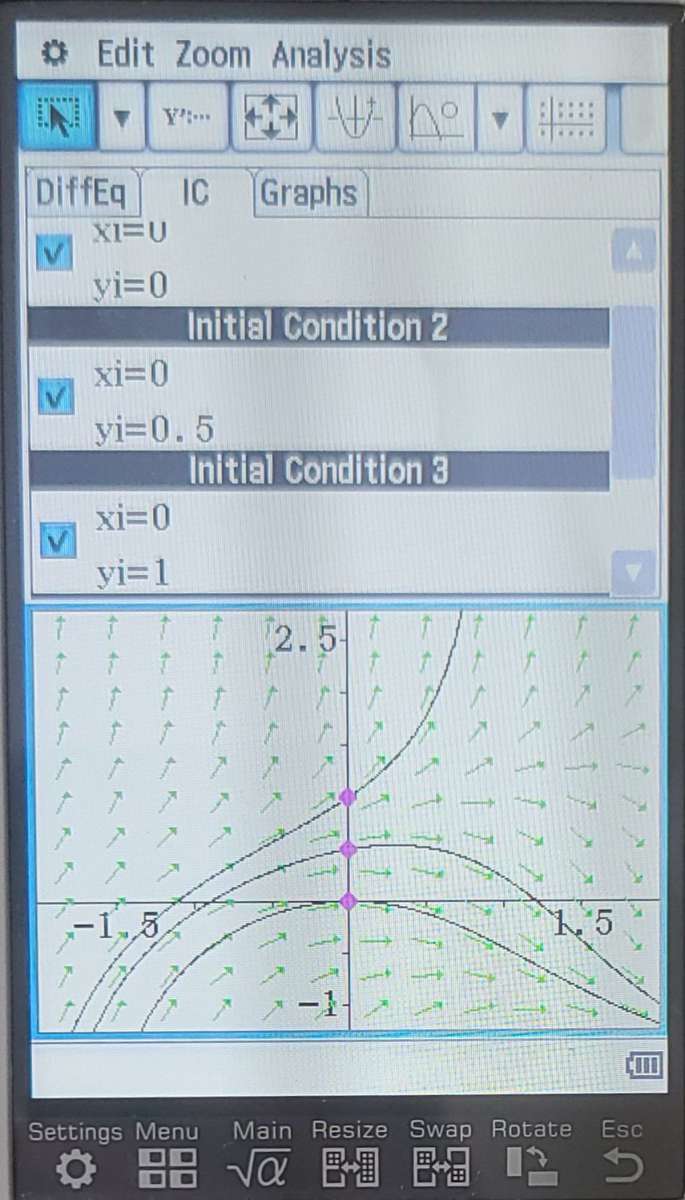
One thing I noticed while generating the solution curves or performing a symbolic calculation is that the user may have to wait for the calculation to be complete. Increasing the processor power would make some solutions occur faster but would also eat up a lot more battery power. The screen refresh seems to be pretty crisp, and calculations normally occur without any wait time. The screen can also be rotated to view large arrays or results that would normally have to be scrolled across the screen.
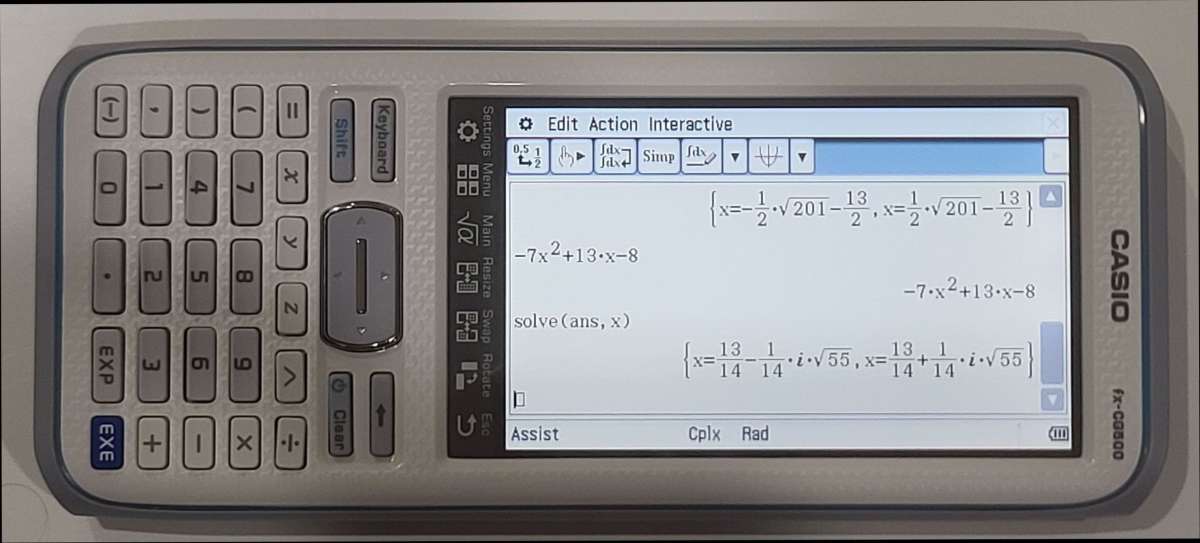
Most windows can be set up to occupy half the screen. The stylus (or finger) can be used to drag entries or results to new lines or between windows. An expression can be dragged to a plot window to graph or to a table window to give a table of results. The stylus or finger can also be used to adjust variables on a pop-up window on the screen to provide dynamically responsive graphs.
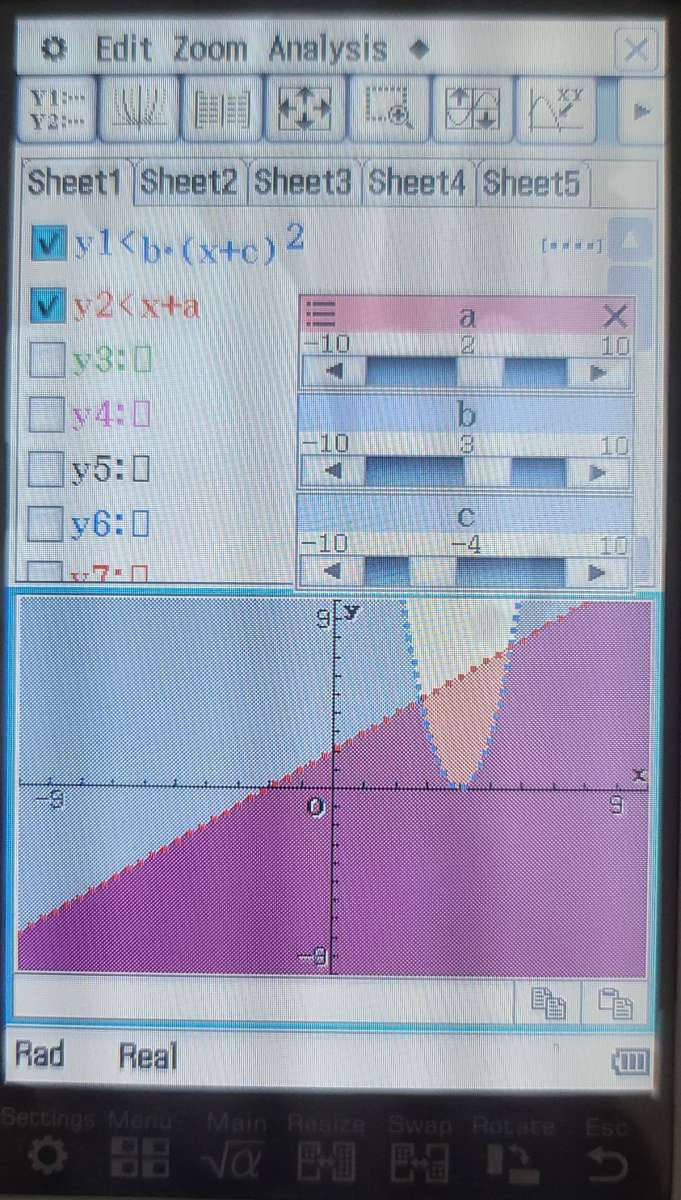
I tried to see if the calculator could evaluate the Error function, which I was exposed to as an engineering student studying chemical diffusion problems. It doesn’t seem like this function is part of the Casio CAS. Fortunately, many other integrals and derivatives came out successfully.
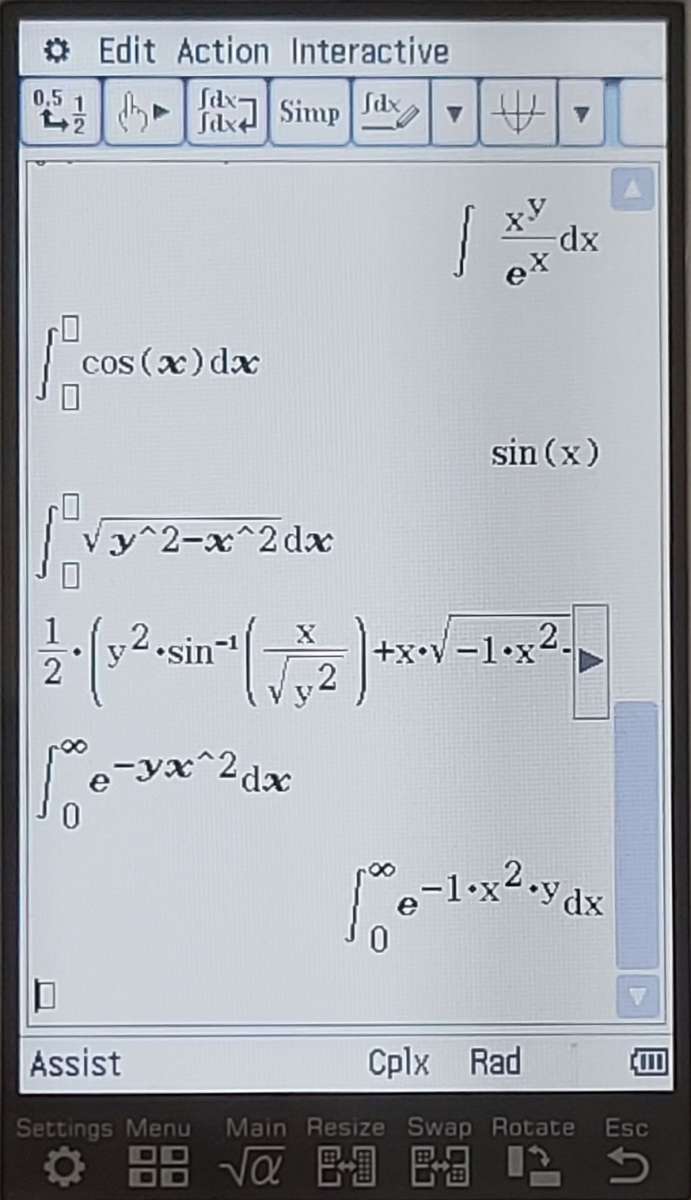
Another feature that I really like is that the most frequently used functions have interactive windows that permit entry of the arguments to functions into labeled fields. Thus, for the simple interest example, the data can be entered into the fields rather than entered into the formula below. This is a big help since the term is in days and the interest is in percent. Entering a term in months and a decimal interest rate like this, simpInt(3,0.05,2500), will yield an incorrect answer even though the data is entered in the correct order.
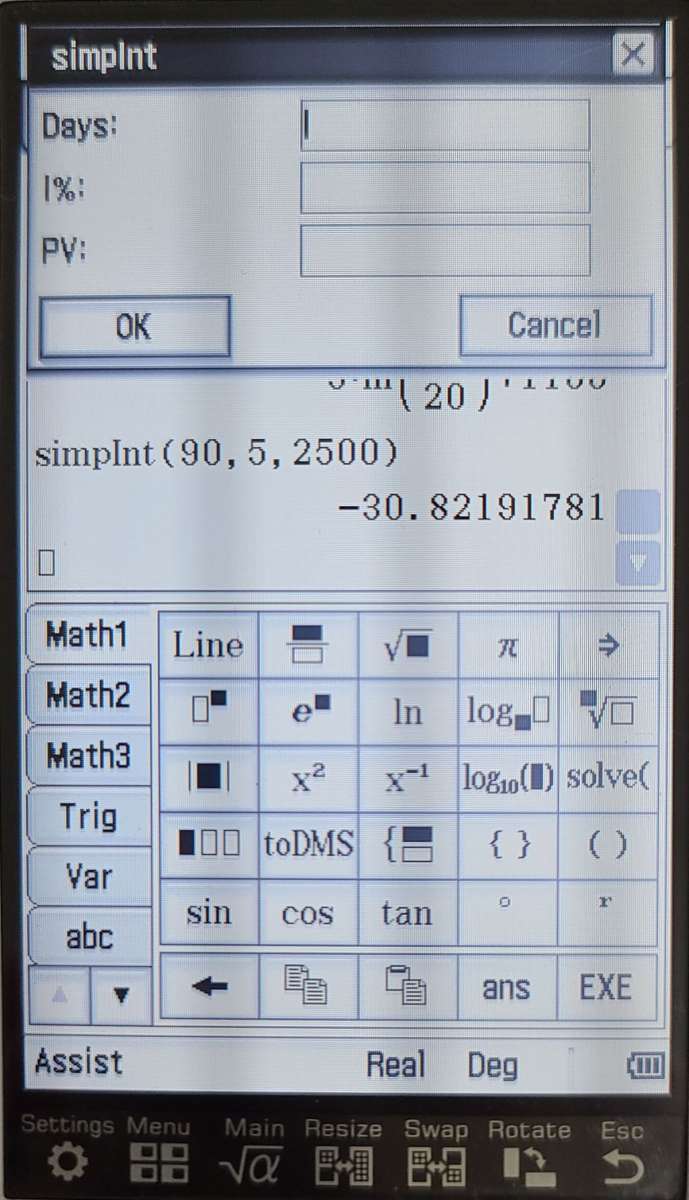
What I like about the Casio fx-CG500 calculator
- Huge Screen
- Clear fonts
- expansive capabilities
What needs to be improved?
- Heavy and delicate
- No shift shortcut button help screen
- No replacement stylus
Final thoughts
The Casio fx-CG500 calculator is somewhat of a unicorn because it is easy to use and useful for a child who is first learning to add and also for a college engineer who is taking advanced-level courses. The fact that this hasn’t changed in 7 years and is still being used demonstrates how useful this design is. The calculator is large and needs to be treated with care. However, the calculator is a fantastic tool and can be used to explore and aid in mathematics from early geometry and algebra to advanced topics.
Price: $169.99
Where to buy: Amazon and Casio
Source: The sample of this product was provided for free by Casio. Casio did not have a final say on the review and did not preview the review before it was published.



Gadgeteer Comment Policy - Please read before commenting
I would have loved this way back when I was still in HS/College. My main concern now is whether it would be worked in for many of the classes that tend to still “require” TI-84 calculators for their courses. I know that’s a big thing around us in Texas and getting any other type of graphing calculator in is usually frowned on. 🙁
Colleges can’t make you get it, while high school depends on the teacher.